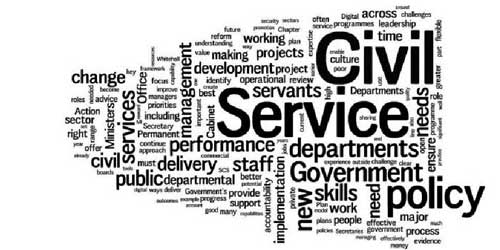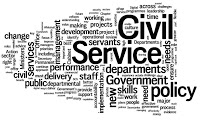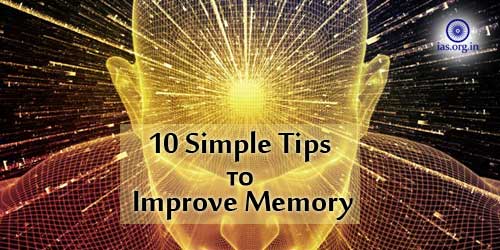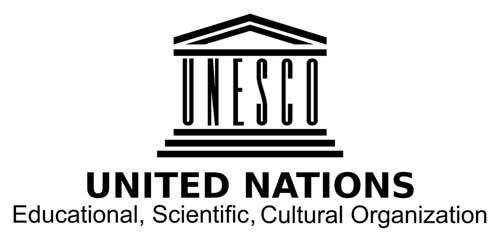Civil Service
Today in History – 27 February
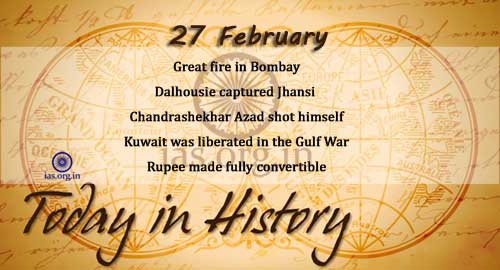
1803
Great fire in Bombay.
1844
Dominican Republic gained independence from Haiti.
1854
Lord Dalhousie captured Jhansi under the East India Company.
Also Read: How East India Company Established British Empire in India? Explained.
1931
Chandrashekhar Azad of Hindustan Republican Army shot himself to avoid British police arrest at Alfred Park, Allahabad.
Don’t Miss: National Movement of India: 1920 to 1940
1933
German Reichstag building in Berlin was destroyed by fire.
1951
The 22nd Amendment to the United State’s Constitution was ratified, limiting the US President to two terms.
1956
G. V. Mavlankar, first speaker of Lok Sabha, passed away.
1987
UN Secretary General Javier Perez de Cuellar recieved the Jawaharlal Nehru award for International Understanding.
1991
Kuwait was liberated in the Gulf War.
Also Read: Important Wars and Battles
1993
Rupee made fully convertible in Manmohan Singh’s third successive budget.
1996
In the Jain hawala case, non bailable warrants of arrest issued against 10 politicians including BJP leader L.K. Advani, former Dy. PM Devi Lal and former Union Ministers.
1996
Manmohan Singh presents the vote-on-account as part of the interim budget in Lok Sabha for 1996-97 with a Rs. 5000 crore deficit.
1999
Union Budget presented. Fiscal deficit cut to 4.4 per cent.
2012
Ali Abdullah Saleh stepped down as president of Yemen after months of protests.
Also Read:
Today in History – 26 February
Today in History – 25 February
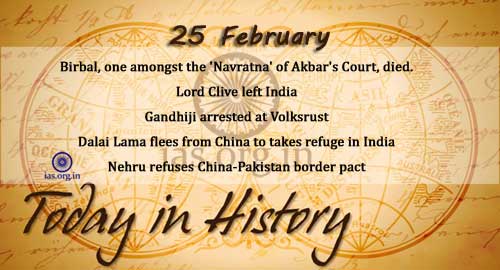
1510
Portuguese Catholics conquer Goa under Albuquerque, the then Governor, to serve as capital of their Asian maritime empire beginning conquest and exploitation of India by Europeans.
1586
King Birbal, renowned wit and one amongst the ‘Navratna’ of Emperor Akbar’s Court, died in a war with Usuf Jard Kabile.
1760
Lord Clive left India. His successors as Governors of India were J. Holwell and H. Vansittart from July 1760 to 1765. He was re-posted to India on May 3, 1765.
1909
Gandhiji arrested at Volksrust; sentenced to 3 months.
1910
Dalai Lama, Tibeten monk, flees from Chinese troops and takes refuge in India.
1963
Nehru refuses to recognize China-Pakistan border pact in New Delhi.
1968
Judge Mohammad Hidayatullah became the Chief Justice of India. He held this office till 16/12/1970.
1976
India announces plan to penalize parents who have more than two children.
1977
Second satellite Earth Station established at Dehradun.
1998
Tendulkar’s first first-class 204* for Mumbai vs Australia.
10 Simple Tips to Improve Your Memory Magically
The first strategy is to get your mind to understand and absorb the information you are about to read. The goal is to improve your memory and have a general idea of the subject or topic and explore just enough to become curious and excited about it.
How to Memorize or Remember What You Study or Read Instantly?
To best way to summarize or consolidate what you have just read after completion of the assigned chapter or topic, do what is, we often call a 3 R’s Strategy i.e; Recap, Review and Reinforce.
Underlining or highlighting
The concept is simple, underline or highlight the main ideas and any information you like or find valuable. Underlining forces you to stop and focus on what you are underlining; this extra attention works as a boost for your memory.
Learn Visually
Information on pictures, charts, or diagrams is much easier to remember than the same information presented to you verbally. You visualize things as you learn them, often by looking.
Must Read: How to Improve your Reading Speed?
Frequently write and rewrite the notes
Remember that “Writing Once Equals Reading Thrice”. Try writing out whatever you need to memorize. After writing it out, read it aloud a couple of times. This works especially well for memorizing paragraphs of writing in another language. Rather than memorizing it from flashcards, consider replacing the lyrics of your favorite song with what you’re trying to memorize.
If you are having particular difficulty with one of the existing notes, take the old note and put it somewhere else, where you will see it more often.
Always read with a pacer
It can be your finger or a pencil or a fine-tip marker pen, so as to control the visual sweep of the saccadic movement of your eyeballs; all fast readers attest to this method.
Take a short break
It’s important to keep your mind fresh, so once you think you have something roughly memorized, take a 20- to 30-minute break. Do something you enjoy that’s easy to accomplish (i.e., something that doesn’t involve a lot of learning) during that time.
Improve your memory
After your break, test yourself again to see if you’ve still memorized everything. If you get it all right, you probably have it. If not, work on the sections you’re having trouble with.
Also Read: How to Perform Your Best on Exam Day
Place a Post
Place it at a location you frequently visit, such as your locker or your bedroom door, your study table. Read it every time you pass by. Align your notes by color, vertically, and horizontally. This note will not only help cement this association in your mind, it will help with the next step too.
Jotting Notes
Taking notes and writing on the margin will help you reinforce and improve your memory . Sometimes you transcribe or summarize what you just read, other times you write questions, observations, ideas, and even have discussions with the author. Writing notes at the margin of the book they are called “Marginalia”.
Rest and sleep
A brief rest after learning something can help you remember it a week later. A full night’s sleep helps you learn new skills or retain information. Even napping can help consolidate your memories, and maybe even make you more creative. This is great news for those of us who like to nap during the day, and is a signal to all of us that staying up all night to revise probably isn’t a good idea.
Don’t Read: How to Utilise Time Effectively
Remember
Last but not least, most trusted way to improve your memory is by reading the paragraph or short note article repeatedly couple of times. Say them aloud until you’re able to remember them. Repeat this process until you can say all the materials without the paper. This is something you can do to get an overview of what you have learnt. It is useful to retain the knowledge for shorter span of time, but not suitable for important topics.
More Tips
- Turn the facts into a song and make up a beat to remember because most people can remember it by hearing it in a certain way like in the music version.
- Go to a place with no distractions or gadgets to disturb or distract you.
Read Also How to Crack IAS Exam? 10 Tips for IAS Preparation
The United Nations Educational, Scientific and Cultural Organization (UNESCO)
The United Nations Educational, Scientific and Cultural Organization (UNESCO) is a specialized agency of the United Nations (UN). Its purpose is to contribute to peace and security by promoting international collaboration through education, science, and culture in order to further universal respect for justice, the rule of law, and human rights along with fundamental freedom proclaimed in the UN Charter. It is the heir of the League of Nations’ International Commission on Intellectual Cooperation.
The Constitution of United Nations Educational, Scientific and Cultural Organization was introduced and signed by 37 countries, and a Preparatory Commission was established. The Preparatory Commission operated between 16 November 1945, and 4 November 1946—the date when UNESCO’s Constitution came into force with the deposit of the twentieth ratification by a member state.
Must Read: United Nations International Children’s Emergency Fund (UNICEF)
United Nations Educational, Scientific and Cultural Organization has 195 member states and nine associate members. UNESCO has offices in many locations across the globe; its headquarters are located at Place de Fontenoy in Paris, France, now called the World Heritage Centre. The Headquarters of United Nations Educational, Scientific and Cultural Organization was inaugurated on 3 November 1958.
The General Conference consists of the representatives of UNESCO’s Member States. It meets every two years, and is attended by Member States and Associate Members, together with observers for non-Member States, intergovernmental organizations and Non-Governmental organizations (NGOs).
UNESCO’s field offices are categorized into four primary office types based upon their function and geographic coverage: cluster offices, national offices, regional bureaux and liaison offices.
United Nations Educational, Scientific and Cultural Organization pursue its objectives through five major Programs:
- Education
- Natural sciences
- Social and human sciences
- Culture
- Communication and information
Also Read: United Nations Organisation (UNO)
UNESCO’s Aim
UNESCO’s aim is “to contribute to the building of peace, the eradication of poverty, sustainable development and intercultural dialogue through education, the sciences, culture, communication and information”.
United Nations Educational, Scientific and Cultural Organization enjoys official relations with 322 international non-governmental organizations (NGOs). Most of these are what UNESCO calls “operational”, a select few are “formal”. The highest form of affiliation to UNESCO is “formal associate”.
Elections for the renewal of the position of Director-General took place in 2017. Audrey Azoulay was elected the new Director-General.
United Nations Educational, Scientific and Cultural Organization is known as the “intellectual” agency of the United Nations. At a time when the world is looking for new ways to build peace and sustainable development, people must rely on the power of intelligence to innovate, expand their horizons and sustain the hope of a new humanism.
Don’t Miss: The United Nations Environment Programme (UNEP)


